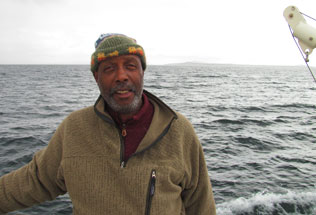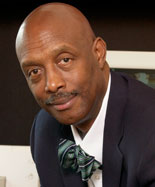 |
|||||
| Office Of Minority Affairs & Diversity | Calendar | Make a Gift | UW Alumni | |||||
|
Spring 2010 | Return to issue home
Faculty Spotlight: Dr. Warren Buck
Dr. Warren Buck, physics professor and Chancellor Emeritus at UW Bothell, recently joined a portion of Around the Americas—an epic 25,000-mile sailing expedition that is currently circumnavigating North and South America with the mission of inspiring, educating and engaging citizens to protect our fragile ocean environments. Dr. Buck, a sailing enthusiast since 1970, met the 64-foot boat, Ocean Watch, in Mar del Plata, Argentina, and sailed with the crew to the Falkland Islands, a territory of the United Kingdom 400 miles southeast of South America. Dr. Buck arrived in Mar del Plata on Dec. 29 and was part of the crew from Jan. 5-16. As a visiting scientist with the expedition, he conducted experiments and wrote a blog for the UW Bothell Web site. The Around the Americas voyage initially set sail from Seattle on May 31, 2009 and is due to return to Seattle in June. Dr. Buck learned about the expedition through his association with the Pacific Science Center (he is currently a board member) which is the science and education partner for Around the Americas. "When it came up I thought, oh my goodness, this is a great idea and as a sailor myself, I thought it was a wonderful thing to do," he said.
While onboard, Dr. Buck worked with automatic experiments that streamed data back to the Applied Physics Lab at UW, including the measurement of temperature gain or loss in the atmosphere, as well as the measurement of water temperature, air temperature, relative humidity of the air and water density. He conducted a few experiments by hand, including taking pictures of cloud structures to cross-reference what was recorded by overhead satellites. Dr. Buck also took pictures of the sun (and the rings around the sun caused by light coming into the atmosphere) with a special device to examine the levels of chemicals in the atmosphere. The most significant area of study for Dr. Buck related to the physical oceanography itself, and in particular waves. "I’ve always liked waves and one of the reasons I went on this trip was because I have always wanted to sail in that part of the world," he said. "It’s always been known as a place where the sailing is tough. There is a lot of wind down there partly because there is very little land to block that wind the goes around the earth." Another reason for the treacherous waves in that area has to do with the continental shelf stretching out as far as 300-400 miles, compared to the 50-100 mile distance off the coast of Alaska for example. "When you look at the geo map you can clearly see it," Dr. Buck said. "That is why the waves are so terrible down there. I rediscovered what everybody knew who had studied that before. It was very gratifying to learn a little bit more about why the sailing was so tough there." In addition to the experiments he helped with, Dr. Buck felt the Around the Americas expedition was significant for other reasons. "The voyage itself is trying to highlight the health of the oceans and their fragility," he said. "We talked to people about that and not many were aware of what the oceans do for us and what we are doing to them. The voyage also brought home (the fact) that more and more, if you look at it in a different way, South and North America is really just one continent surrounded by water. The oceans are connected—the Atlantic and the Pacific are connected at the south tip of Chile and at the north through Canada, through the Northwest passage. It’s a realization that we are not separate any more. We’ve been thinking of ourselves as separate and I think it’s time for us to think about it being one continent." In addition to his recent sailing expedition, Dr. Buck is also the acting director of the new Science and Technology Program at UW Bothell. The program began last spring and in a span of nine months, has grown to include 11 faculty members. They are now working to put together new majors in climate science, biology, interactive media and technology and electrical engineering. Photos courtesy Warren Buck Spring 2010 | Return to issue home |
|||||
|
|||||

